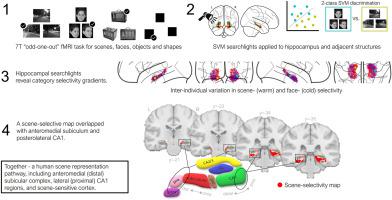Neuropsychologia ( IF 2.6 ) Pub Date : 2023-12-29 , DOI: 10.1016/j.neuropsychologia.2023.108783 Marie-Lucie Read , Samuel C. Berry , Kim S. Graham , Natalie L. Voets , Jiaxiang Zhang , John P. Aggleton , Andrew D. Lawrence , Carl J. Hodgetts

|
Prior univariate functional magnetic resonance imaging (fMRI) studies in humans suggest that the anteromedial subicular complex of the hippocampus is a hub for scene-based cognition. However, it is possible that univariate approaches were not sufficiently sensitive to detect scene-related activity in other subfields that have been implicated in spatial processing (e.g., CA1). Further, as connectivity-based functional gradients in the hippocampus do not respect classical subfield boundary definitions, category selectivity may be distributed across anatomical subfields. Region-of-interest approaches, therefore, may limit our ability to observe category selectivity across discrete subfield boundaries. To address these issues, we applied searchlight multivariate pattern analysis to 7T fMRI data of healthy adults who undertook a simultaneous visual odd-one-out discrimination task for scene and non-scene (including face) visual stimuli, hypothesising that scene classification would be possible in multiple hippocampal regions within, but not constrained to, anteromedial subicular complex and CA1. Indeed, we found that the scene-selective searchlight map overlapped not only with anteromedial subicular complex (distal subiculum, pre/para subiculum), but also inferior CA1, alongside posteromedial (including retrosplenial) and parahippocampal cortices. Probabilistic overlap maps revealed gradients of scene category selectivity, with the strongest overlap located in the medial hippocampus, converging with searchlight findings. This was contrasted with gradients of face category selectivity, which had stronger overlap in more lateral hippocampus, supporting ideas of parallel processing streams for these two categories. Our work helps to map the scene, in contrast to, face processing networks within, and connected to, the human hippocampus.
中文翻译:

CA1/下皮质复合体的场景选择性:7T 的多体素模式分析
先前对人类的单变量功能磁共振成像(fMRI)研究表明,海马体的前内侧皮下复合体是基于场景的认知的中心。然而,单变量方法可能不够敏感,无法检测空间处理(例如 CA1)中涉及的其他子字段中的场景相关活动。此外,由于海马体中基于连通性的功能梯度不遵循经典的子域边界定义,因此类别选择性可能分布在解剖子域中。因此,感兴趣区域方法可能会限制我们跨离散子域边界观察类别选择性的能力。为了解决这些问题,我们将探照灯多变量模式分析应用于健康成年人的 7T fMRI 数据,这些健康成年人对场景和非场景(包括面部)视觉刺激进行同时视觉奇数辨别任务,假设场景分类是可能的位于前内侧下皮复合体和 CA1 内但不限于多个海马区域。事实上,我们发现场景选择性探照灯图不仅与前内侧下托复合体(远端下托、前/旁下托)重叠,而且还与下 CA1、后内侧(包括压后)和海马旁皮质重叠。概率重叠图揭示了场景类别选择性的梯度,最强的重叠位于内侧海马体,与探照灯的发现一致。这与面部类别选择性的梯度形成对比,后者在更外侧的海马体中具有更强的重叠,支持这两个类别的并行处理流的想法。我们的工作有助于绘制场景图,与人类海马体内并连接到的面部处理网络形成鲜明对比。



























 京公网安备 11010802027423号
京公网安备 11010802027423号